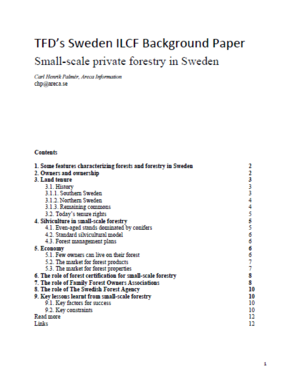TFD’s Sweden ILCF Background Paper Small-scale private forestry in Sweden
There are a few things that distinguish Swedish forests and forestry from many other parts of the world:
Flat ground. Only a tiny fraction of our forests grow on real steep slopes or in high mountainous areas. Our forest ground is normally quite flat, which makes it easy to grow and harvest timber.
A good road infrastructure. There are more than 400,000 kilometres of roads in Sweden. Appr. 50 per cent of those are forest roads, built with the single purpose to enhance haulage of timber to the industries. A majority of these roads were built in the 1940’s and 50’s, often with economic support from the State.
No “basic” land-use conflict. Our forests are normally growing on stony soils, so called “morains”, which are unsuitable for agriculture (but there are, of course, other conflicts, such as reindeer husbandry in the forest, the moose population and conservation issues).
Supportive ecosystems. Trees will eventually grow on most sites even without special reforestation activities – although we can promote our preferred species and enhance growth with active regeneration and forest management.
Degradation no longer an issue. During the 19th century we had a growing population, and an increasing level of livestock grazing in the woods. This resulted in degraded forests. But from the 1930s onwards, cattle are almost completely separated from the forest land. In northern Sweden, we had a period with an over-exploitation of our forests from around 1850 to 1950. Only the big trees were cut in the old growth stands and very limited regeneration measures were performed. But from 1950 onwards, a system with clear-cutting followed by planting was introduced on a broad scale in Sweden, both in the south and the north. Thanks mainly to the reduced livestock grazing and the improved silviculture, the standing volume in our forests has increased substantially. Since 1920, when we had the first nationwide forest inventory, the volume in the Swedish forests has almost doubled.

